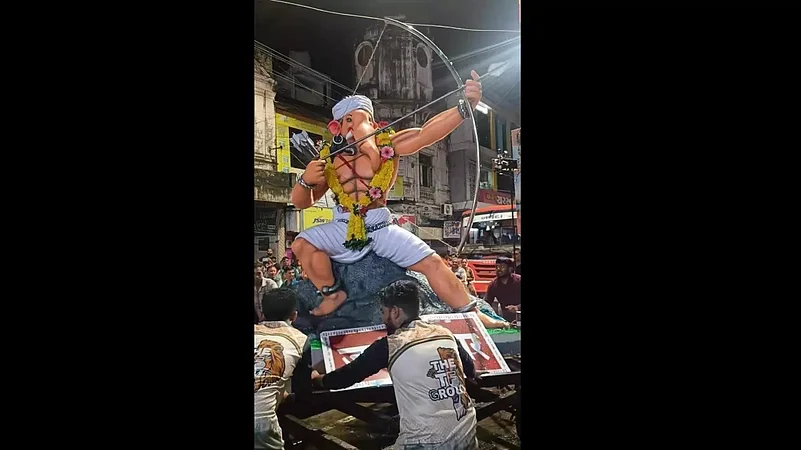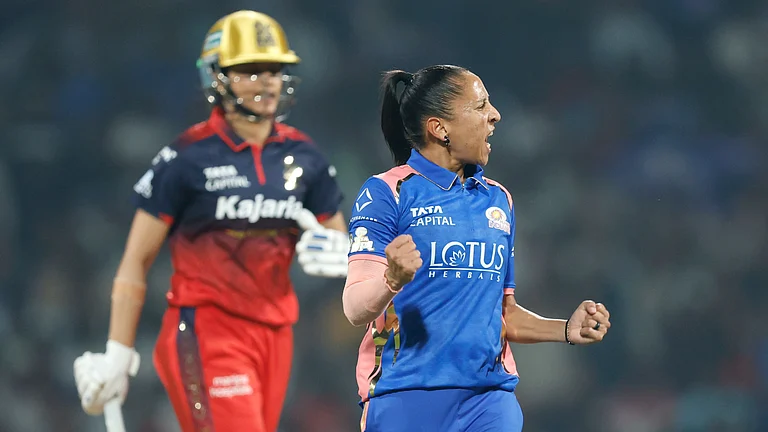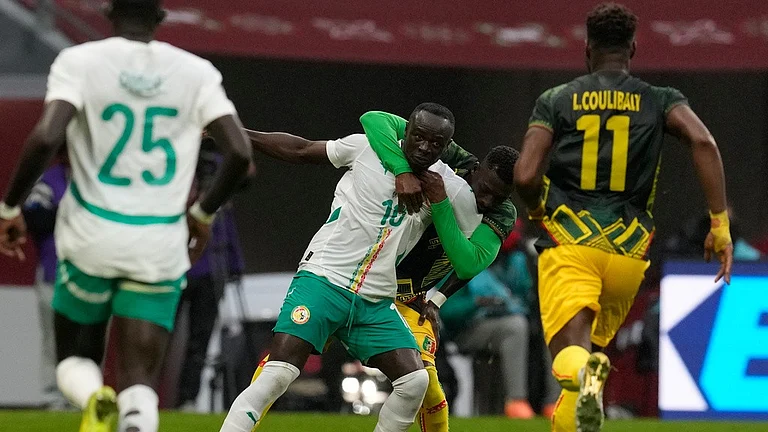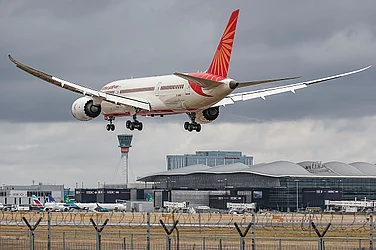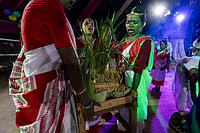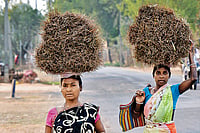The image of an idol has been shared extensively on social media since the night of September 19 in which Birsa Munda—Dharti Aaba (the lord of the Earth), as he is addressed reverently among Adivasis—has been depicted as Lord Ganesha with a trunk. The images are from the Rajpipla municipal area in Narmada district of Gujarat where a Ganesh idol superimposed on Birsa Munda’s image was allegedly placed inside a puja pandal on September 19, on the occasion of Ganesh Chaturthi. Several Adivasis activists have criticised this.
“Lord Ganesha being depicted as Birsa Munda, holding a bow and arrow, is an insult to Adivasis across the nation,” says Raj Vasava, an Adivasi activist, who lives in Bharuch, Gujarat. “We do not know the exact motive behind this, but it feels like an attempt to Hinduise Birsa Munda and our nature-worshipping belief system, despite knowing very well that Adivasis have a different religion.”
Other Adivasi activists from Gujarat, including Praful Vasava, Anil Vasava, and Mahesh Vasava, the former chairperson of the Rajpipla Municipal Council, too, have expressed their displeasure. They insist that Lord Ganesha and Birsa Munda have not had any connection historically.
The pandal where this idol has been placed comes under the jurisdiction of Ward Number 2 of Rajpipla municipality. Richa Vasava, 23, the councillor from this Ward, who is also an Adivasi, supports the idol and says: “Those who are opposing this know nothing about Birsa Munda. Even though Lord Ganesha has been depicted wearing Adivasi attire, the idol is not meant to resemble Birsa Munda. There is nothing wrong with the idol. Though I worship nature like all Adivasis, but I respect all religious beliefs and celebrate all festivals.”
The pandal committee that organises the 10-day celebration starting with Ganesh Chaturthi, also includes Adivasis. (Richa) Vasava says that even though Lord Ganesha has been shown in Adivasi attire for the first time in Rajpipla, similar idols have been placed in pandals in the past in other parts of Gujarat and in metro cities.
The Adivasi community in Jharkhand, which has been raising the issue of their places of nature-worship and lands being allegedly usurped for building temples, has reacted as well. After the Gujarat idol made headlines, the debate has once again come to the fore in the state.
Jharkhand-based writer and journalist Jacinta Kerketta believes that by taking over the places of worship and indigenous lands belonging to Adivasis for building temples an attempt is being made to ‘Hinduise’ them. Recently, Hemlal Murmu, the former minister in the state government and Jharkhand Mukti Morcha (JMM) leader, alleged in a public meeting that idols of Lord Hanuman were being erected in several places across the state to claim and usurp Adivasi land.
There is a Sun temple in Adalhatu village in the Bundu subdivision, just 40 kilometres from Ranchi, located off the Ranchi-Tatanagar highway. The foundation for the temple was laid in 1991. At the time, the Adivasi community had carried out a sit-in protest against the temple’s construction under the leadership of Padma Shri Ramdayal Munda.
Vasavi Kiro, 60, writer and the former member of the Jharkhand Women’s Commission, who was also one of the protestors, says: “The spot where the Sun temple stands today is actually jointly owned Munda land (commons). This cannot be handed over even to the Oraon tribe, let alone to non-Adivasis. The construction of a temple on this land is a clear violation of Article 240 of the Chota Nagpur Tenancy Act.”
The land belonged to one Chandi Singh Munda, which was taken over by Pavan Maru, who hails from a wealthy and influential family in Jharkhand, and the RSS. “Munda was made to sign on a plain paper after which his rights over the land were waived off. Although a temple for Adivasi deity Singa Bonga was promised, a temple came up instead. This paved the way for spreading of Hindu culture in this Munda-dominated area,” says Kiro.
The Dewri temple in the Tamar constituency of Ranchi became popular after former Indian cricket captain Mahendra Singh Dhoni’s frequent visits. The entire Tamar region is Adivasi-dominated. The native village of Adivasi intellectual Ramdayal Munda also falls in the region.
Talking about the temple, Munda’s son and researcher Gunjal Ikir Munda, 32, says: “Dewri is an Adivasi goddess. Earlier there was just a rock on the location. The Adivasis have been worshipping it for generations. Later, a temple was constructed here and Hindus started coming in large numbers, eventually claiming ownership on the shrine.”
In 1970, the ownership dispute was heard in the court. “The court verdict said that Munda pahans (priests) could worship six days a week, and one day would be allotted to Hindu priests. This seemed like a forced compromise. Ideally, it should have been handed over to the Munda community,” says Gunjal.
The construction of the temple had an impact on the nature-worshipping practices of Adivasis, as well as their culture and language, he says, and adds that many Hindu temples around Ranchi like Pahari, Harmu and Argora are linked to Adivasi places of worship. “For instance, there is a small temple of Pahan Baba—an Adivasi priest or shaman—near the Pahari temple,” says Gunjal.
Narrating the history of Dewri temple, Kiro says: “Tamar and Bundu were Munda areas. Dewri is a Munda goddess and it is believed she protects the villages and people. As women are worshipped among Adivasis, they are symbolised by the goddess.”
Around 150 years ago, Brahmins started arriving in the area. Jagdish Trigunayat, a Brahmin teacher, has written in his books Munda Folk Tales and Bansuri Baj Rahi that a man named Shekhar, a Brahmin, started narrating tales of Ram and Sita to the Mundas living in different villages, says Kiro. “These deities then entered the Munda pantheon, and priests started performing Hindu rituals. In the later years, the Dewri temple proved to be the death knell for many Adivasi traditions,” she adds.
She claims that more than a dozen temples in Jharkhand, including the Maluti temples in Santhal Pargana and the Rajrappa temple in Ramgarh district, have been built by replacing or destroying Adivasi places of worship.
She insists that the depiction of Lord Ganesha as Birsa is part of the politics to assimilate the Adivasis’ Sarna religion into Sanatan or Hindu tradition. “If today, in the age of social media, they can dare to depict Birsa as Lord Ganesha, how easy it would have been for them to appropriate Adivasi villages and belief systems 200 years ago. Today, temples are being built in almost every Adivasi village, Jagrans (Hindu religious programmes) are being held, and the Sarna traditions of worshipping and preserving nature—be it from the Munda, Santhal, Ho or Oraon community—are being hijacked.”
The RSS has repeatedly been accused of ‘Hinduising’ Adivasis. The Akhil Bharatiya Vanvasi Kalyan Ashram, an organisation linked to the RSS, is held responsible for this push, say experts. There are 14 units of the group working among Adivasis across India. One of the groups, Janjati Suraksha Manch, is active in Jharkhand and its regional convenor Sandip Oraon admits that Adivasi places of worship have been taken over by other religions and this continues to happen. “This is being done by all religions, but why are questions raised only on Hindus and their temples? Why are the Muslim and Christian communities that are encroaching upon Adivasis lands not being opposed? However, I agree that Adivasi places of nature-worship should be left alone in their original state. They should not be altered or interfered with in any way,” he says.
When asked if temples are being constructed in Adivasi villages, Oraon says that this can be ascertained by visiting these villages.
(Translated by Iqbal)







